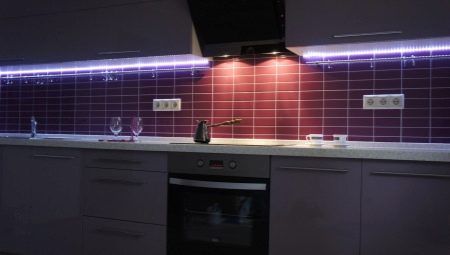LED lighting is not only an element of beauty in the design of kitchens, but also practicality. In addition to decorative lighting, the power of modern LEDs allows you to illuminate the cook’s workplace no worse, and sometimes better, of fluorescent lamps. With the same power from LED strips and spotlights, you get up to 5 times more light than from similar incandescent bulbs.

How to choose?
The selection criteria for LED strip are as follows.
- Moisture proof. The LED strip, which does not have effective protection against water splashes, in the event of dripping, can cause a short circuit and cause a fire. The degree of protection against water vapor and spray is indicated by the numbers after the letters IP. The rating scale against water splashes is from 0 to 99: IP33 - the tape has no protection against water, IP65 - partial protection from the LEDs and current paths, IP67 and IP68 - protection against moisture on both sides.

Unprotected type IP33 requires a special cover, duct, transparent hose or silicone coating covering the entire tape.
- The number of LEDs per meter of tape. The tape is produced in the form of small clusters of 3 LEDs connected in series, but the clusters themselves are connected in parallel using a common bus. There are tapes with the number of 30, 60, 120 and 240 LEDs per meter. The more of them, the greater the brightness and the total power consumption of each meter. To illuminate a kitchen or room, 30 or 60 pieces per meter are enough, full (working) lighting requires 120 or 240 LEDs.

- Angle of illumination. Work lighting often requires an angle of 30-90 degrees - for example, to illuminate the table under the kitchen cabinets. Decorative, noticeable to everyone who enters the kitchen, may require an angle of 120 degrees.

Power consumption by different tapes
| LED marking | The number of LEDs per meter | The taken power, W / m |
| SMD-3528 (3.5 * 2.8 mm) | 60 | 4,8 |
| 120 | 9,6 | |
| 240 | 19,2 | |
| SMD-5050 (5 * 5 mm) | 30 | 7,2 |
| 60 | 14,4 | |
| 120 | 28,8 |

For monochrome ribbons, the luminous flux is maximum. Three-color RGB diodes have a different luminous flux - its value varies depending on the control electronics supplying different voltage to the corresponding elements.


Decorative light is also used as emergency lighting at night.
Color matching
If you need a specific color, today on sale there are LEDs of all seven primary colors of the rainbow. Choosing, for example, blue, you will see that the meat layers of the ham or sausage will turn black and purple, and in red they will appear whitish, not a bright red.
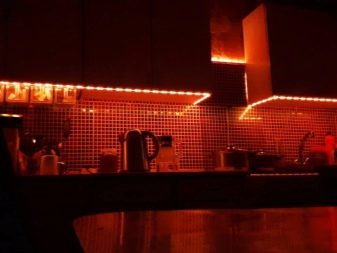
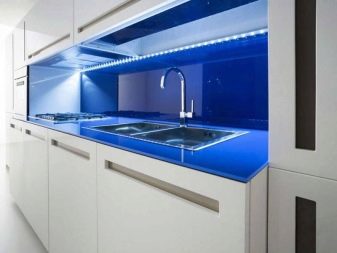
For white diodes, ultraviolet radiation is delayed by a thin-film phosphor coating, making the last glow in UV rays with a white tint. The principle of operation of fluorescent lamps is based on the same.

Colour temperature
Shades close to white are marked based on color temperature. They can be from yellow-orange (2500 K) to blue (7000 K). The chosen shade depends on the interior of the room: you are unlikely to choose white light with a touch of purple or blue for furniture in warm colors. If, on the contrary, the design contrast is emphasized or you want to change the shades of furniture and walls - you will do the opposite: light-beige furniture in a bluish light can become light turquoise.

Where to place what tapes?
White glow tapes are located above the workplace either as a general (upper) light on the ceiling or immediately below it.


Decorative - around the perimeter of furniture, for example, when you need to highlight the kitchen cabinet itself or the lower cabinets, a table and a sink. In some cases, a decorative tape highlights the floor around the perimeter - such tapes are placed in the lower part of the kitchen.

Shiny (porcelain stoneware, tile) floor reflects such light well, decorating the kitchen with the chosen color of the LED strip.
Power supply
The power of the power supply and LED strip are coordinated. For example, a 12 Volt power adapter that produces (as described) a current of 2 Amps, which corresponds to the declared power of 24 Watts, should power 5 m of LED strip SMD-3528 (3.5 * 2.8 mm) with a number of diodes of 60 PCS. / m Exceeding the calculated power by at least 1.5 times will lead to the fact that the light from the worker will become decorative. And although reducing the maximum working brightness to moderate levels will extend the life of the LED strip up to 20 times, from overload the power supply will soon fail due to constant overheating. To extend its service life, they take power with a 20-25% margin - for example, for the same 5-meter tape, the adapter power is selected at least 30 watts.

It is unacceptable to plug the LED strip directly into a 220 V household outlet - the strip will burn immediately. Feeding a tape with an alternating voltage of 50 Hz from a step-down transformer without a rectifying diode bridge is undesirable - flickering is noticeable from the edge of the eye and will be annoying.
Which power supply is best?
For the kitchen, like the LED strip itself, the power supply is selected waterproof. The best solution is a power adapter with an aluminum radiator case. A stabilizer (driver) works in the high-quality adapter circuit, which prevents tape overload from power surges.

Wiring diagrams
Do not connect two 12 V LED strips to a common 24 V adapter or 4 to a 48 V adapter, 20 directly to a wall outlet. If one of them breaks down, the rest will take on more than the calculated voltage - and also burn out.The whole scheme will fail, like a collapsed house of cards.
The fact is that two different LEDs even from the same batch always differ from each other by hundredths and thousandths of a volt in the exact optimal value of the supply voltage. In order for several LEDs from one cluster to work on the declared years (in hours), the responsible manufacturer uses the tolerance of the ohmic resistance of the quenching resistor, somewhat larger than its real (calculated) value. And he does not always guess: in ribbons, although rare, individual clusters fail.
In order for several tapes to work optimally, a current amplifier that supports a single mode for all tapes receiving voltage from one power supply is connected to each of them.
For a time-varying glow mode, a dimmer is used - an additional driver that smoothly regulates the luminous flux of each ribbon. It is based on pulse-width control cards (PWM controllers) that specify the optimal width of current pulses - with them LEDs work without overload. RGB tapes have 4 outputs: one is common, the other three are for each of the colors. They are connected to a microcontroller that regulates the luminous flux of each of the colors.

Several tapes longer than 5 m are connected in parallel. If the power of one power supply is not enough for all devices, and the circuit provides for controllers, then a separate power supply is used to power them.
Recommendations
- Do not connect the tape “backwards” - it requires strict polarity.
- The maximum length of the connecting line between the power supply and the tape is 10 m. Otherwise, wires with a cross section greater than 1 mm may be required or the brightness of the light will drop due to current losses in the connecting line.
- Do not bend or twist the tape. A sharp bend is done by soldering pieces of the same wire that comes from the power supply.
- It is advisable to hide the high power tape in an aluminum box.
- The power supply is located in a well-blown place - then it will not overheat.
- To exclude possible overheating of the LEDs, the tape is placed on a special heat-conducting substrate. Aluminum box is the best solution.
- Place narrowly directed LEDs farther from the wall - to exclude an uneven border between the illuminated and shadow areas.
- If the lighting is set as working, it is advisable to abandon the matte lid on the box: it not only scatters the light, but also absorbs part of it, which will negatively affect the efficiency and require large expenses for such lighting.

Installation sequence
In addition to LED strips, a profile (or box), a power supply, wires and, possibly, a controller, amplifier and dimmer, The following tools and consumables will be required:
- jigsaw for cutting slots under profiles;
- soldering iron and rosin, solder, flux;
- double-sided tape and electrical tape;
- scissors.


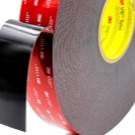



Having prepared the necessary tools, do the following:
- if the tape is of low power with an adhesive layer on the back (invoice) - stick it directly on the cabinet, before that, degreasing this part of its surface with alcohol or simply washing and drying the cabinet before installation;
- lead the cable to the connection point, removing it as much as possible from prying eyes, using the borders of the transitions between the cabinet and the wall for this purpose or by driving it from the inside of the cabinet;
- to mask the tape, hide it with a profile or box, similar in color to the cabinet;
- mount the power supply (and other electronic units, if necessary);
- lay a separate box for the cable, matching the color of the wall;
- connect all the wires, check the circuit with a tester for a short circuit, then turn on the assembled system.
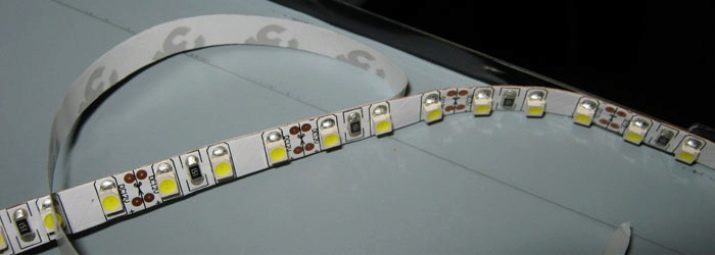


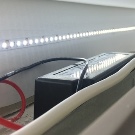
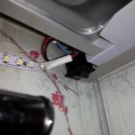

If all devices are operational, the lighting will work.
About the installation of LED strip in the kitchen under the cabinets, see the video below.
